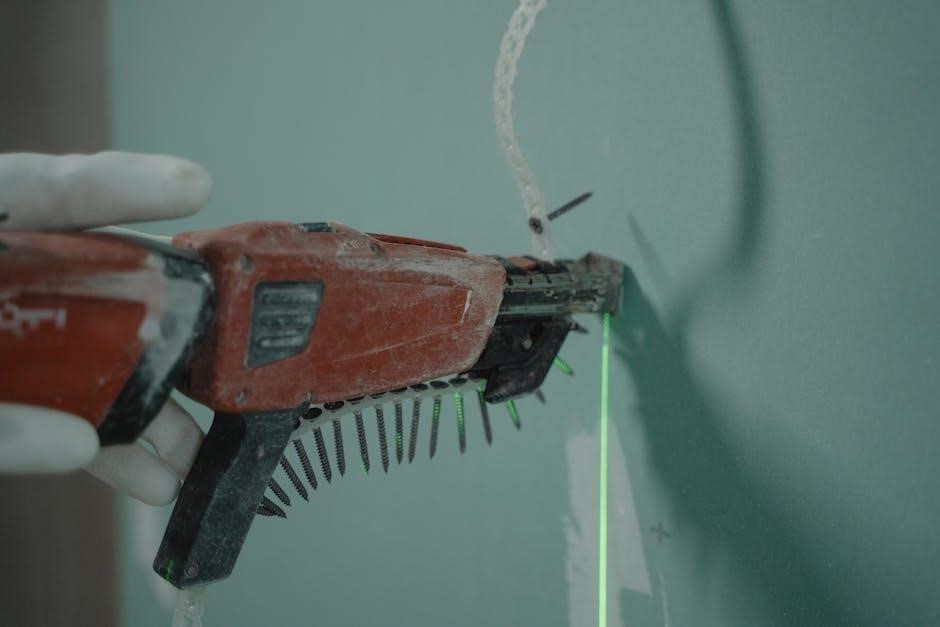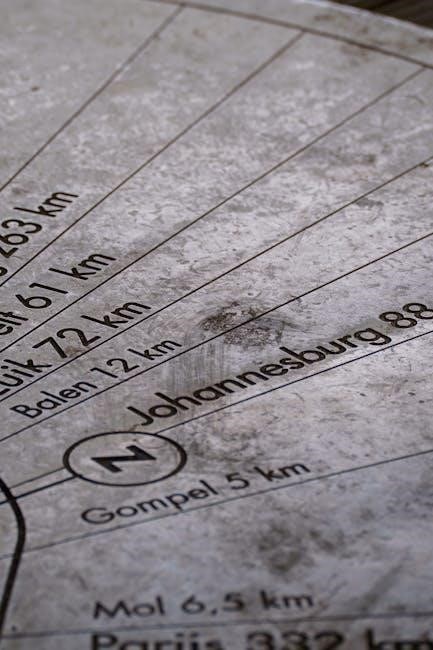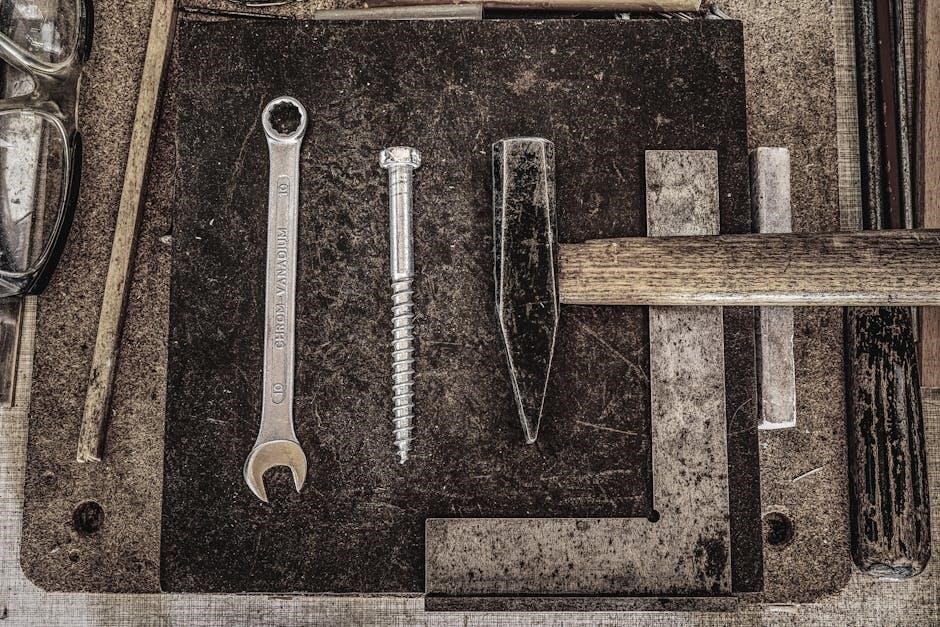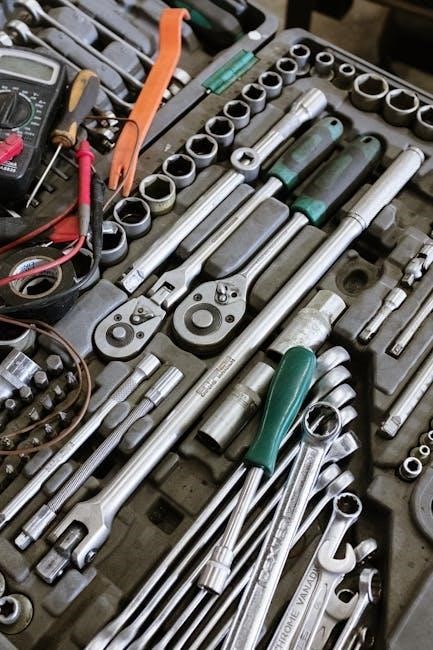The Kreg Jig Screw Size Guide helps woodworkers choose the correct screws for their projects by providing charts and recommendations based on material thickness and thread type.
What is the Kreg Jig?
The Kreg Jig is a revolutionary tool designed for creating precise pocket-hole joints in woodworking projects.
It consists of a sturdy aluminum extrusion‚ a drill guide‚ and a depth stop‚ allowing users to drill angled holes for screws.
Perfect for furniture‚ cabinetry‚ and other woodwork‚ the Kreg Jig ensures strong‚ hidden joints with minimal effort.
Its simplicity and versatility make it a favorite among woodworkers‚ from hobbyists to professionals.
The jig is compatible with various materials‚ including softwoods‚ hardwoods‚ and thick stock.
By aligning the drill guide with the material‚ users can achieve consistent results and professional-grade finishes.
Why Screw Size Matters in Pocket Hole Joinery
Screw size is critical in pocket hole joinery because it directly affects the strength and durability of the joint.
Using screws that are too short may result in weak joints‚ while screws that are too long can split the material or protrude awkwardly.
The Kreg Jig system relies on proper screw length to ensure the screw engages both pieces of wood without over-penetrating.
Material thickness and type also influence screw selection‚ as different woods require varying thread patterns and lengths for optimal hold.
Coarse-thread screws are ideal for softwoods‚ while fine-thread screws work better with hardwoods‚ ensuring maximum grip and stability.
Incorrect screw size can lead to loose or tight joints‚ compromising the structural integrity of the project.
Thus‚ selecting the right screw size is essential for achieving professional-grade results in pocket hole joinery.

Understanding Screw Anatomy for Kreg Jigs
Understanding screw anatomy is crucial for proper joinery. Key components include the shank‚ thread‚ tip‚ and head. Thread type (coarse or fine) and length ensure optimal material engagement and joint strength.
Thread Type: Coarse vs. Fine Threads
Choosing the right thread type is essential for strong joints. Coarse-thread screws are designed for softer woods like pine or plywood‚ offering aggressive grip and minimizing the risk of splitting. Fine-thread screws‚ on the other hand‚ are better suited for hardwoods such as oak or maple‚ providing a tighter fit and reducing the likelihood of material damage.
The thread type selection depends on the material’s density and the desired joint strength. Coarse threads are more forgiving in softer materials‚ while fine threads excel in denser woods. Always consult the Kreg Jig Screw Size Guide or the Screw Selector Tool for specific recommendations tailored to your project needs. Proper thread selection ensures optimal performance and durability in your woodworking creations.
Screw Length and Material Thickness
Screw length is determined by the thickness of the materials being joined. The Kreg Jig Screw Size Guide provides a chart to help select the correct screw length based on material thickness. For example‚ 1/2″ thick materials typically require 5/8″ screws‚ while 3/4″ thick materials need 1″ screws. For thicker materials over 1″‚ longer screws such as 1-1/4″ or 2″ are recommended to ensure proper hold. Proper screw length ensures the screw doesn’t protrude or leave the joint weak. Always measure the material thickness accurately and refer to the Kreg chart for precise recommendations. This ensures a strong‚ flush joint without compromising the integrity of the wood.
Head Types and Driving Features
Kreg screws are designed with specific head types and driving features to ensure optimal performance in pocket hole joinery. The most common head type is the pan-head‚ which provides a flush finish when driven into the pocket hole. Driving features include a square drive (Robertson) or star drive (Torx)‚ designed to prevent cam-out and ensure easy driving. These features enhance torque transfer‚ reducing the risk of stripping the screw head. The pan-head design allows the screw to sit flush with the wood surface‚ creating a professional finish. Proper alignment of the driver bit with the screw’s driving feature is crucial for secure joints. Kreg screws also come in coarse or fine threads‚ catering to different wood types. This combination of head types and driving features ensures strength and reliability in pocket hole joints‚ making Kreg screws ideal for various woodworking projects. Always match the screw’s driving feature to the driver bit for optimal results.

How to Choose the Right Screw for Your Project
Measure material thickness‚ use the Kreg chart to select screw length‚ and determine thread type based on the wood material for optimal joint strength and durability.
Step 1: Measure Material Thickness
Measuring the thickness of your material is the first critical step in selecting the right screw for your project. Use a tape measure or caliper to accurately determine the thickness of the wood or material you are working with. This measurement will guide you in choosing the appropriate screw length to ensure proper joint strength and prevent screws from protruding or splitting the material. For example‚ if your material is 1/2″ thick‚ you will need a screw length that matches this measurement to ensure the screw does not overextend. Accurate measurement is essential‚ as even small miscalculations can lead to joint instability or material damage. Once you have this measurement‚ you can refer to the Kreg Jig Screw Size Guide to find the recommended screw length and type for your specific project. This step sets the foundation for a strong and durable joint.
Step 2: Select Screw Length Using the Kreg Chart
With your material thickness measured‚ the next step is to use the Kreg Chart to determine the appropriate screw length. The chart provides a clear correlation between material thickness and screw length‚ ensuring optimal joint strength. For example‚ if your material is 1/2″ thick‚ the chart will recommend a screw length of 5/8″. Similarly‚ for 3/4″ thick materials‚ a 1″ screw is typically suggested. It’s important to follow the chart closely‚ as using a screw that is too short may result in a weak joint‚ while a screw that is too long could split the material or protrude excessively. By aligning your material thickness with the chart’s guidelines‚ you can ensure the screw length is perfectly suited for your project. This step is crucial for achieving professional-grade results and preventing common issues like joint instability or material damage.
Step 3: Determine Thread Type Based on Material

After selecting the screw length‚ the next step is to determine the appropriate thread type for your material. Kreg screws come in two primary thread options: coarse and fine. Coarse-thread screws are designed for softer woods‚ such as pine or plywood‚ as they provide a stronger hold and better resistance to pull-out. Fine-thread screws‚ on the other hand‚ are ideal for harder woods like oak or maple‚ as they minimize splitting and offer a smoother engagement. The material’s density and type play a critical role in this decision. For example‚ coarse threads are recommended for materials prone to tearing‚ while fine threads are better suited for dense woods where splitting is a concern. Always refer to the Kreg chart or the Screw Selector tool to ensure the correct thread type is chosen for your specific project‚ as this directly impacts joint strength and durability.

The Kreg Jig Screw Size Guide
The Kreg Jig Screw Size Guide is essential for woodworkers to select the right screws for their projects‚ considering material thickness and thread type for optimal results. It provides charts and tools for accurate selection.
Kreg Screw Length Chart for Different Wood Thicknesses
The Kreg Screw Length Chart is a vital tool for ensuring proper screw selection based on material thickness. It provides clear recommendations‚ matching screw lengths to wood thicknesses for optimal joint strength. For example‚ 1-1/4″ screws are ideal for 3/4″ thick materials‚ while longer screws are used for thicker stock. The chart is organized by material thickness‚ offering screw lengths that ensure the screw penetrates properly without splitting the wood. This guide is part of the Kreg Jig system‚ helping users avoid common mistakes like using screws that are too short or too long. By following the chart‚ woodworkers can achieve precise‚ professional results. It’s a must-have reference for projects requiring pocket hole joinery‚ ensuring durability and stability in every joint. The chart is simple to use‚ making it accessible for both beginners and experienced woodworkers.
Setting the Drill Guide for Proper Screw Depth
Setting the drill guide for proper screw depth is crucial for achieving strong and reliable joints with the Kreg Jig; The drill guide features an adjustable stop that allows you to set the precise depth for drilling pocket holes. To begin‚ measure the thickness of your material and select the appropriate screw length using the Kreg Screw Length Chart. Once you’ve chosen the correct screw‚ refer to the chart or the Kreg Jig manual to determine the corresponding drill depth. Adjust the drill guide stop to match this measurement‚ ensuring it aligns with the screw length you’re using. Properly setting the drill guide prevents screws from being too deep or too shallow‚ which can weaken the joint. For optimal results‚ perform a test drill on scrap wood to confirm the depth before working on your project. This step ensures accurate and consistent results‚ making your woodworking projects durable and professional-looking.

Coarse Thread vs. Fine Thread Screws
Coarse-thread screws are designed for softwoods‚ offering deep grooves for strong grip‚ while fine-thread screws suit hardwoods‚ reducing risk of splitting with shallower threads.
When to Use Coarse Thread Screws
Coarse-thread screws are ideal for softwoods‚ plywood‚ and medium-density fiberboard (MDF). Their aggressive‚ deep threads provide a strong grip in softer materials‚ reducing the risk of screws loosening over time. Use coarse-thread screws when working with materials like pine‚ spruce‚ or fir‚ as they hold better in wood with less density. They are also recommended for thicker materials‚ as the coarse threads create a more secure joint. However‚ avoid using coarse-thread screws in hardwoods‚ as they may cause splitting. Always refer to the Kreg Jig Screw Size Guide to ensure the correct screw length for your material thickness. Proper alignment and drill guide settings are crucial for optimal results. Coarse-thread screws are a reliable choice for projects requiring strength and durability in softer wood types.
When to Use Fine Thread Screws
Fine-thread screws are designed for hardwoods‚ dense materials‚ and projects requiring a more discreet joint. Their less aggressive threads minimize splitting and offer a cleaner finish. Use fine-thread screws for materials like oak‚ maple‚ or cherry‚ as they provide a strong hold without compromising the wood’s integrity. They are also suitable for thin or pre-finished woods‚ where coarse threads might cause damage. Fine threads are ideal when working with dense or hard materials‚ ensuring a secure joint without the risk of splitting. Always consult the Kreg Jig Screw Size Guide to match the screw length with your material thickness. Proper drill guide alignment is essential for accurate results. Fine-thread screws are a great choice for projects requiring precision and a polished appearance in harder wood types.

Common Mistakes in Screw Selection
Common mistakes include using screws that are too short or too long for the material thickness and selecting the wrong thread type for the wood being used.
Using the Wrong Screw Length for Material Thickness
Using the wrong screw length is a common mistake that can weaken joints or damage materials. Screws that are too short may not hold securely‚ while screws that are too long can protrude or split the wood. Proper screw length ensures strong‚ invisible joints. Always measure the thickness of your materials accurately and refer to the Kreg Screw Length Chart for guidance. For example‚ 3/4″ thick wood typically requires 1″ screws‚ while 1/2″ thick wood uses 5/8″ screws. Double-checking the chart and material thickness before drilling prevents errors. Additionally‚ ensure the drill guide is set correctly to avoid over-drilling. Using the Kreg Screw Selector Tool can also help confirm the right choice. By following these steps‚ you can avoid costly mistakes and ensure your projects are durable and professional-looking. Always prioritize accuracy for optimal results in pocket hole joinery.
Choosing the Incorrect Thread Type for the Wood
Choosing the wrong thread type for your wood can compromise joint strength and durability. Coarse-thread screws are designed for softwoods and thicker materials‚ providing better grip in softer fibers. Fine-thread screws‚ on the other hand‚ are ideal for hardwoods and thinner materials‚ reducing the risk of splitting. Using coarse threads on hardwoods can lead to screws being too aggressive‚ causing splits‚ while fine threads on softwoods may not hold securely. Always match the thread type to the wood species and thickness for optimal results. Refer to the Kreg Screw Size Guide or the Kreg Screw Selector Tool to ensure compatibility. For example‚ softwoods like pine benefit from coarse threads‚ while hardwoods like oak require fine threads. This simple step ensures stronger‚ more reliable joints and prevents costly mistakes in your woodworking projects. Proper thread selection is essential for achieving professional-quality results.

Troubleshooting Screw Fit Issues
If screws are too loose or tight‚ check drill guide settings and material thickness. Adjust the jig or screw length to ensure proper fit and joint integrity.
What to Do If Screws Are Too Loose
If screws are too loose‚ ensure the correct screw length is used for the material thickness. Refer to the Kreg chart to verify the recommended screw length. Adjust the drill guide to the proper setting for the screw being used. If the issue persists‚ consider switching to a screw with a coarse thread‚ as it provides better grip in softer materials. Always double-check the material thickness and screw length chart to ensure compatibility. Proper drill guide alignment and accurate depth settings are crucial for secure joints. Using the wrong screw length or thread type can lead to loose joints‚ so consulting the Kreg Screw Selector tool can help identify the right screws for your project. Ensuring tight‚ secure joints is essential for the durability and strength of the finished piece.
What to Do If Screws Are Too Tight
If screws are too tight‚ it may cause the material to split or the joint to become over-stressed. To address this‚ first‚ check the screw length against the material thickness using the Kreg chart. A screw that is too long for the material can cause excessive tightness. Consider switching to a shorter screw length or using fine-thread screws‚ which are less aggressive and reduce the risk of overtightening. Ensure the drill guide is set correctly to avoid drilling too deep. If the issue persists‚ slight adjustments to the drill guide setting can help achieve the proper screw depth. Using the correct screw type and length‚ as recommended by the Kreg Screw Selector tool‚ will help prevent screws from being too tight and ensure a secure‚ stress-free joint. Proper alignment and accurate settings are key to avoiding material damage and achieving professional results.

Advanced Tips for Using the Kreg Jig
Using the Kreg Jig effectively requires optimizing drill settings and screw selection for precise pocket holes and strong joints. Regular maintenance and using the correct drill bits ensure optimal performance and longevity of the Kreg Jig.
How to Optimize Joint Strength with Proper Screw Size
Optimizing joint strength with the Kreg Jig begins with selecting the right screw size for your material thickness. Measure the wood accurately and use the Kreg Screw Size Chart to ensure proper screw length. Coarse-thread screws are ideal for softwoods‚ while fine-thread screws work best for hardwoods. Always set the drill guide to the recommended depth to avoid over-drilling‚ which can weaken the joint. Using the Kreg Screw Selector Tool can further enhance accuracy. Properly aligned pocket holes and precise screw placement are critical for maximum strength. Regularly maintain your Kreg Jig and use sharp drill bits to ensure clean‚ accurate holes. By following these guidelines‚ you can achieve durable‚ professional-grade joints in your woodworking projects. This attention to detail ensures your creations are both functional and long-lasting.
Using the Kreg Screw Selector Tool for Accuracy
The Kreg Screw Selector Tool simplifies the process of choosing the right screws for your project. Available online‚ this tool requires inputting the material thickness and type to recommend the ideal screw length and thread type. It eliminates guesswork by providing precise matches based on Kreg’s standardized charts. The tool also considers factors like the specific Kreg Jig model being used‚ ensuring compatibility and optimal results. By utilizing this resource‚ woodworkers can avoid common mistakes such as using screws that are too short or too long‚ which can compromise joint strength. The Screw Selector Tool is particularly useful for beginners who are still learning the nuances of pocket hole joinery. It’s a time-saving solution that ensures every project meets professional standards‚ making it an essential asset for any woodworking workshop.

Kreg Jig Screw Size Guide for Specific Projects
The Kreg Jig Screw Size Guide offers tailored recommendations for various projects‚ ensuring optimal screw selection based on material thickness and joint requirements for thin or thick wood.
Choosing Screws for Thin Materials (1/2″ or Less)
When working with thin materials (1/2″ or less)‚ selecting the right screw is crucial to avoid over-drilling and ensure joint strength. The Kreg Jig Screw Size Guide recommends using shorter screws‚ such as 5/8″ or 3/4″‚ depending on the specific thickness. For 1/2″ material‚ a 5/8″ screw is ideal‚ as it provides adequate hold without risking material damage. Coarse-thread screws are often preferred for thin woods‚ as they offer better grip in softer‚ less dense fibers. Always refer to the Kreg chart to match screw length with material thickness. Proper drill guide settings are also essential to prevent screws from protruding or causing splits. Using the correct screw size ensures strong‚ invisible joints‚ even in delicate projects like drawer backs or thin shelving. This step is vital for achieving professional-looking results in woodworking.
Choosing Screws for Thick Materials (Over 1″)
For thick materials (over 1″)‚ selecting the right screw ensures strong‚ durable joints without compromising material integrity. The Kreg Jig Screw Size Guide recommends using longer screws‚ such as 1-1/4″ or 1-1/2″‚ to accommodate the increased thickness. These lengths provide sufficient penetration to secure the joint firmly. Fine-thread screws are often ideal for thicker‚ denser woods‚ as they offer superior holding power. Always consult the Kreg chart to match screw length with material thickness. Proper drill guide settings are critical to avoid over-drilling or uneven joints. Using screws that are too short can result in weak joints‚ while screws that are too long may protrude or cause splitting. By following the guide‚ you can ensure optimal joint strength and a professional finish‚ even for heavy-duty projects like cabinetry or large furniture pieces.
The Kreg Jig Screw Size Guide is essential for ensuring project success. Proper screw selection enhances joint strength and overall project quality‚ making it a valuable resource for woodworkers.
Final Tips for Mastering Screw Size Selection
To master screw size selection for your Kreg Jig‚ always use the Kreg Screw Selector Tool for accuracy. Double-check material thickness measurements to ensure proper fit. Regularly clean and maintain your drill guide to prevent misalignment. Start with standard screw lengths and adjust based on project requirements. Sorting screws by length and type beforehand saves time during assembly. Finally‚ keep your workpiece flat and stable during drilling to avoid uneven screw placement. By following these tips‚ you’ll achieve strong‚ professional-quality joints every time.
Resources for Further Learning
For further learning‚ visit the official Kreg Tool website‚ which offers detailed guides‚ videos‚ and FAQs. Their community forums are a great place to ask questions and share tips. Additionally‚ Kreg’s YouTube channel provides step-by-step tutorials and project ideas. The Kreg Pocket Hole Screw Chart is an essential resource for mastering screw size selection. For hands-on practice‚ consider purchasing the Kreg R3 Pocket Hole Jig Manual‚ which includes detailed instructions and troubleshooting tips. Lastly‚ explore Kreg’s “Get Started” guide for beginners‚ which covers the basics of pocket hole joinery and screw selection.

